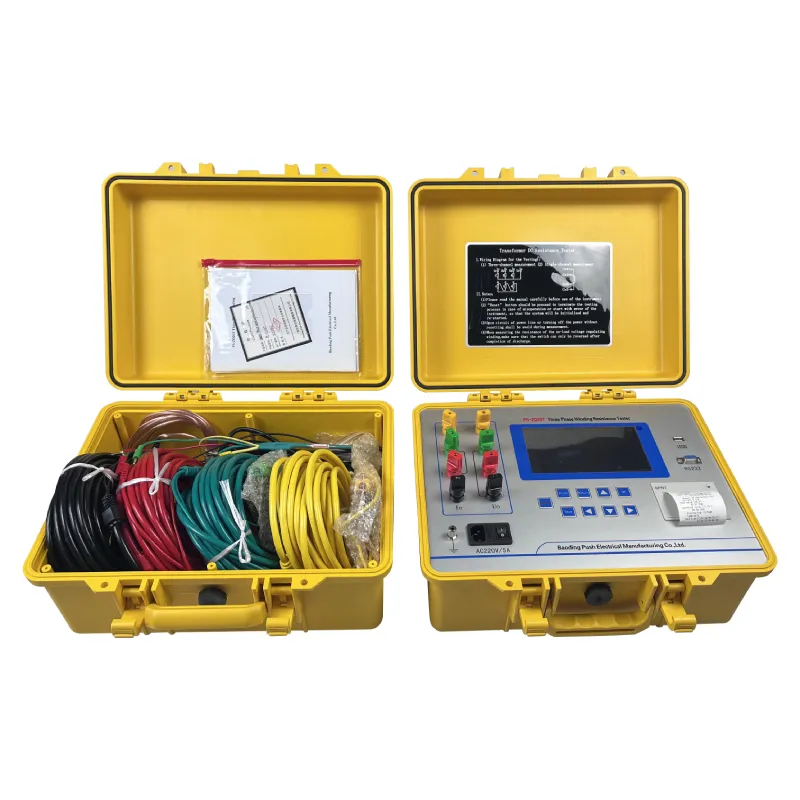 English
English


Comprehensive Analysis of Partial Discharge Testing Methods for Transformer Condition Assessment
Partial Discharge Test of Transformers An Overview
Transformers are crucial components in electrical power systems, functioning to step up or step down voltage levels to facilitate efficient power distribution. However, like all electrical equipment, transformers are susceptible to insulation degradation over time, primarily due to electrical, thermal, and environmental factors. One of the significant forms of insulation failure in transformers is partial discharge (PD). Therefore, the partial discharge test has emerged as a vital diagnostic tool in the maintenance and management of transformer insulation systems.
Partial discharge refers to localized dielectric breakdown of a small portion of a solid or liquid electrical insulation system under high voltage stress. This phenomenon can occur in various forms of insulation within transformers, including solid insulation materials such as paper and resin, as well as in gas-filled spaces within the insulation system. Over time, these discharges can lead to the deterioration of the insulation, which may compromise the transformer’s performance and lead to catastrophic failure if not detected and addressed.
The primary goal of the partial discharge test is to identify, quantify, and locate the sources of partial discharges within a transformer. This proactive approach allows maintenance teams to assess the condition of the insulation and take appropriate steps before serious issues arise. The test can be conducted on both in-service and offline transformers, providing flexibility to power utility operators and maintenance personnel.
The partial discharge testing process typically involves applying a high voltage to the transformer while monitoring for the characteristic signals produced by discharges
. Various methods can be employed to detect these discharges, including1. Ultrasonic Detection This method uses high-frequency sound waves produced by PD events. Specialized ultrasonic sensors can capture these sound waves, which are then analyzed to indicate the presence and intensity of partial discharges.
partial discharge test of transformer

2. Electrical Measurement This approach involves measuring the PD pulses in the electrical signals produced during testing. By using high-frequency current transformers and voltage sensors, testers can analyze the discharge patterns, which help in identifying the severity and potential locations of PD activity.
3. Optical Detection Using advanced imaging techniques, such as high-speed cameras, optical detection systems can visualize the light emitted during partial discharge events. While less common, this technique can provide insightful data on the discharge mechanisms.
Interpreting the results from a partial discharge test requires substantial expertise. Each transformer design and insulation system has particular characteristics that influence PD behavior. By comparing test results with established benchmarks or historical data from similar transformers, technicians can make informed decisions regarding the health of the insulation system.
It is essential to note that while partial discharge testing can significantly extend the operational life of transformers by allowing for timely repairs and replacements, it is not foolproof. Routine inspections and regular monitoring of transformers are equally critical in ensuring their reliability. Moreover, combining PD testing with other diagnostic techniques, such as dielectric response tests and insulation resistance measurements, offers a comprehensive understanding of the overall health of transformer insulation systems.
In conclusion, the partial discharge test is an indispensable tool for ensuring the reliability and longevity of transformers. By enabling early detection of insulation issues, it enhances the operational safety of electrical networks and contributes to the overall efficiency of power distribution systems. In today’s context, where the demand for reliable energy supply is paramount, investing in regular PD testing can be a pivotal strategy for power industry stakeholders.
-
Differences between open cup flash point tester and closed cup flash point testerNewsOct.31,2024
-
The Reliable Load Tap ChangerNewsOct.23,2024
-
The Essential Guide to Hipot TestersNewsOct.23,2024
-
The Digital Insulation TesterNewsOct.23,2024
-
The Best Earth Loop Impedance Tester for SaleNewsOct.23,2024
-
Tan Delta Tester--The Essential Tool for Electrical Insulation TestingNewsOct.23,2024





